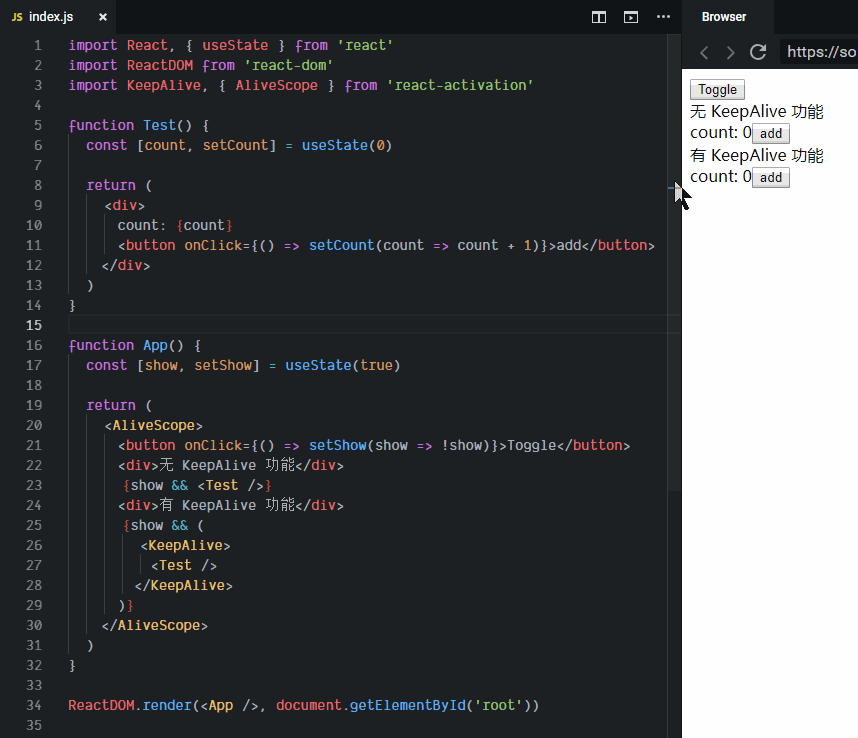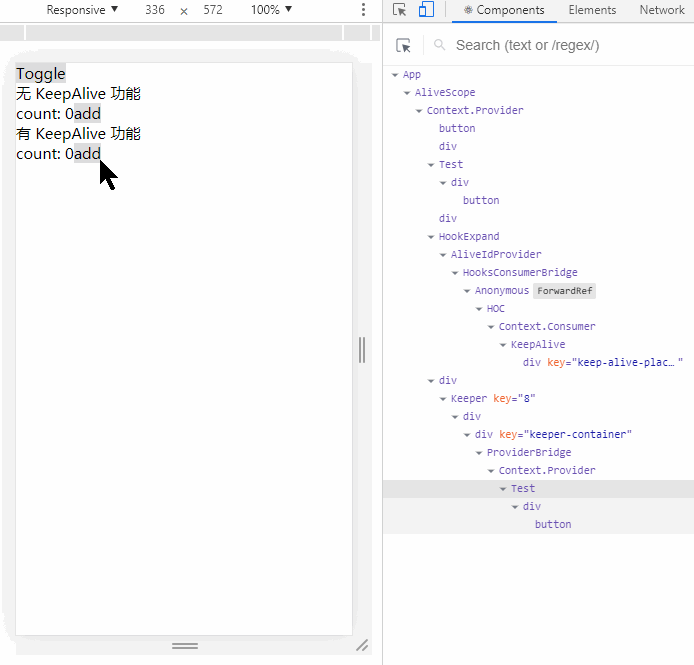NOTICE
- DO NOT use
<React.StrictMode /> - (React v18+) DO NOT use
ReactDOMClient.createRoot, useReactDOM.renderinstead, https://github.com/CJY0208/react-activation/issues/225#issuecomment-1311136388
React Activation
English | 中文说明
HACK Implementation of the <keep-alive /> function in Vue For React
Please also pay attention to official support <Offsreen /> in React 18.x
More stable <KeepAlive /> function with babel pre-compilation
More examples
Compatibility
-
React v16 / v17 / v18
-
Preact v10+
-
Compatible with SSR
Install
yarn add react-activation
# or
npm install react-activationUsage
1. (Optional, Recommended) Add react-activation/babel plugins in .babelrc
The plugin adds a _nk attribute to each JSX element during compilation to help the react-activation runtime generate an unique identifier by render location base on react-node-key.
{
"plugins": [
"react-activation/babel"
]
}(0.11.0+) If you don't want to use Babel, it is recommended that each <KeepAlive> declare a globally unique and invariant cacheKey attribute to ensure the stability of the cache, as follows:
<KeepAlive cacheKey="UNIQUE_ID" />2. Wrap the components that need to keep states with <KeepAlive>
Like the <Counter> component in the example
// App.js
import React, { useState } from 'react'
import KeepAlive from 'react-activation'
function Counter() {
const [count, setCount] = useState(0)
return (
<div>
<p>count: {count}</p>
<button onClick={() => setCount(count => count + 1)}>Add</button>
</div>
)
}
function App() {
const [show, setShow] = useState(true)
return (
<div>
<button onClick={() => setShow(show => !show)}>Toggle</button>
{show && (
<KeepAlive>
<Counter />
</KeepAlive>
)}
</div>
)
}
export default App3. Place the <AliveScope> outer layer at a location that will not be unmounted, usually at the application entrance
Note: When used with react-router or react-redux, you need to place <AliveScope> inside <Router> or <Provider>
// index.js
import React from 'react'
import ReactDOM from 'react-dom'
import { AliveScope } from 'react-activation'
import App from './App'
ReactDOM.render(
<AliveScope>
<App />
</AliveScope>,
document.getElementById('root')
)Lifecycle
ClassComponent works with withActivation decorator
Use componentDidActivate and componentWillUnactivate to correspond to the two states of "activate" and "unactivate" respectively.
FunctionComponent uses the useActivate and useUnactivate hooks respectively
...
import KeepAlive, { useActivate, useUnactivate, withActivation } from 'react-activation'
@withActivation
class TestClass extends Component {
...
componentDidActivate() {
console.log('TestClass: componentDidActivate')
}
componentWillUnactivate() {
console.log('TestClass: componentWillUnactivate')
}
...
}
...
function TestFunction() {
useActivate(() => {
console.log('TestFunction: didActivate')
})
useUnactivate(() => {
console.log('TestFunction: willUnactivate')
})
...
}
...
function App() {
...
return (
{show && (
<KeepAlive>
<TestClass />
<TestFunction />
</KeepAlive>
)}
)
}
...Cache Control
Manually control the cache
-
Add the
nameattribute to the<KeepAlive>tag that needs to control the cache. -
Get control functions using
withAliveScopeoruseAliveController.-
drop(name): (
dropcan only be used for nodes in the cache state. If the node is not cached but needs to clear the cache state, please userefresh)Unload the
<KeepAlive>node in cache state by name. The name can be of typeStringorRegExp. Note that only the first layer of content that hits<KeepAlive>is unloaded and will not be uninstalled in<KeepAlive>. Would not unload nested<KeepAlive>. -
dropScope(name): (
dropScopecan only be used for nodes in the cache state. If the node is not cached but needs to clear the cache state, please userefreshScope)Unloads the
<KeepAlive>node in cache state by name. The name optional type isStringorRegExp, which will unload all content of<KeepAlive>, including all<KeepAlive>nested in<KeepAlive>. -
refresh(name):
Refresh the
<KeepAlive>node in cache state by name. The name can be of typeStringorRegExp. Note that only the first layer of content that hits<KeepAlive>is refreshed and will not be uninstalled in<KeepAlive>. Would not refresh nested<KeepAlive>. -
refreshScope(name):
Refresh the
<KeepAlive>node in cache state by name. The name optional type isStringorRegExp, which will refresh all content of<KeepAlive>, including all<KeepAlive>nested in<KeepAlive>. -
clear():
will clear all
<KeepAlive>in the cache -
getCachingNodes():
Get all the nodes in the cache
-
...
import KeepAlive, { withAliveScope, useAliveController } from 'react-activation'
...
<KeepAlive name="Test">
...
<KeepAlive>
...
<KeepAlive>
...
</KeepAlive>
...
</KeepAlive>
...
</KeepAlive>
...
function App() {
const { drop, dropScope, clear, getCachingNodes } = useAliveController()
useEffect(() => {
drop('Test')
// or
drop(/Test/)
// or
dropScope('Test')
clear()
})
return (
...
)
}
// or
@withAliveScope
class App extends Component {
render() {
const { drop, dropScope, clear, getCachingNodes } = this.props
return (
...
)
}
}
...Automatic control cache
Add the when attribute to the <KeepAlive /> tag that needs to control the cache. The value is as follows
When the when type is Boolean
- true: Cache after uninstallation
- false: Not cached after uninstallation
<KeepAlive when={false}>When the when type is Array
The 1th parameter indicates whether it needs to be cached at the time of uninstallation.
The 2th parameter indicates whether to unload all cache contents of <KeepAlive>, including all <KeepAlive> nested in <KeepAlive>.
// For example:
// The following indicates that it is not cached when uninstalling
// And uninstalls all nested `<KeepAlive>`
<KeepAlive when={[false, true]}>
...
<KeepAlive>
...
<KeepAlive>...</KeepAlive>
...
</KeepAlive>
...
</KeepAlive>When the when type is Function (Recommended)
The return value is the above Boolean or Array, which takes effect as described above.
The final calculation time of when is adjusted to componentWillUnmount lifecicle of <KeepAlive>, the problem that most of the when do not achieve the expected effect can be avoided.
<KeepAlive when={() => true}>
<KeepAlive when={() => [false, true]}>Multiple Cache
Under the same parent node, <KeepAlive> in the same location will use the same cache by default.
For example, with the following parameter routing scenario, the /item route will be rendered differently by id, but only the same cache can be kept.
<Route
path="/item/:id"
render={props => (
<KeepAlive>
<Item {...props} />
</KeepAlive>
)}
/>Similar scenarios, you can use the id attribute of <KeepAlive> to implement multiple caches according to specific conditions.
<Route
path="/item/:id"
render={props => (
<KeepAlive id={props.match.params.id}>
<Item {...props} />
</KeepAlive>
)}
/>Save Scroll Position (true by default)
<KeepAlive /> would try to detect scrollable nodes in its children, then, save their scroll position automaticlly before componentWillUnactivate and restore saving position after componentDidActivate
If you don't want <KeepAlive /> to do this thing, set saveScrollPosition prop to false
<KeepAlive saveScrollPosition={false} />If your components share screen scroll container, document.body or document.documentElement, set saveScrollPosition prop to "screen" can save sharing screen container's scroll position before componentWillUnactivate
<KeepAlive saveScrollPosition="screen" />Principle
Pass the children attribute of <KeepAlive /> to <AliveScope /> and render it with <Keeper />
After rendering <Keeper />, the content is transferred to <KeepAlive /> through DOM operation.
Since <Keeper /> will not be uninstalled, caching can be implemented.
Breaking Change
-
<KeepAlive />needs to pass children to<AliveScope />, so the rendering of the real content will be slower than the normal situationWill have a certain impact on the function of strictly relying on the lifecycle order, such as getting the value of
refincomponentDidMount, as followsclass Test extends Component { componentDidMount() { console.log(this.outside) // will log <div /> instance console.log(this.inside) // will log undefined } render() { return ( <div> <div ref={ref => { this.outside = ref }} > Outside KeepAlive </div> <KeepAlive> <div ref={ref => { this.inside = ref }} > Inside KeepAlive </div> </KeepAlive> </div> ) } }
The above error in
ClassComponentcan be fixed by using thewithActivationhigh-level componentFunctionComponentcurrently has no processing method, you can usesetTimeoutornextTickto delay ref getting behavior@withActivation class Test extends Component { componentDidMount() { console.log(this.outside) // will log <div /> instance console.log(this.inside) // will log <div /> instance } render() { return ( <div> <div ref={ref => { this.outside = ref }} > Outside KeepAlive </div> <KeepAlive> <div ref={ref => { this.inside = ref }} > Inside KeepAlive </div> </KeepAlive> </div> ) } }
-
Destructive impact on
Contextafter
react-actication@0.8.0withreact@16.3+, this question has been automatic fixedreact-actication@0.8.0withreact@17+you Need to make the following changes to achieve automatic repairimport { autoFixContext } from 'react-activation' autoFixContext( [require('react/jsx-runtime'), 'jsx', 'jsxs', 'jsxDEV'], [require('react/jsx-dev-runtime'), 'jsx', 'jsxs', 'jsxDEV'] )
Versions below
react-actication@0.8.0need to be repaired manually, refer to the followingProblem reference: https://github.com/StructureBuilder/react-keep-alive/issues/36
<Provider value={1}> {show && ( <KeepAlive> <Consumer> {( context // Since the rendering level is broken, the context cannot be obtained here. ) => <Test contextValue={context} />} </Consumer> </KeepAlive> )} <button onClick={toggle}>toggle</button> </Provider>
Choose a repair method
-
Create
ContextusingcreateContextexported fromreact-activation -
Fix the affected
ContextwithfixContextexported fromreact-activation
... import { createContext } from 'react-activation' const { Provider, Consumer } = createContext() ... // or ... import { createContext } from 'react' import { fixContext } from 'react-activation' const Context = createContext() const { Provider, Consumer } = Context fixContext(Context) ...
-
-
Affects the functionality that depends on the level of the React component, as follows
- [x] Fix
withRouter/hooksof react-router - [x]
Error Boundaries(Fixed) - [x]
React.Suspense & React.lazy(Fixed) - [ ] React Synthetic Event Bubbling Failure
- [ ] Other undiscovered features
- [x] Fix




